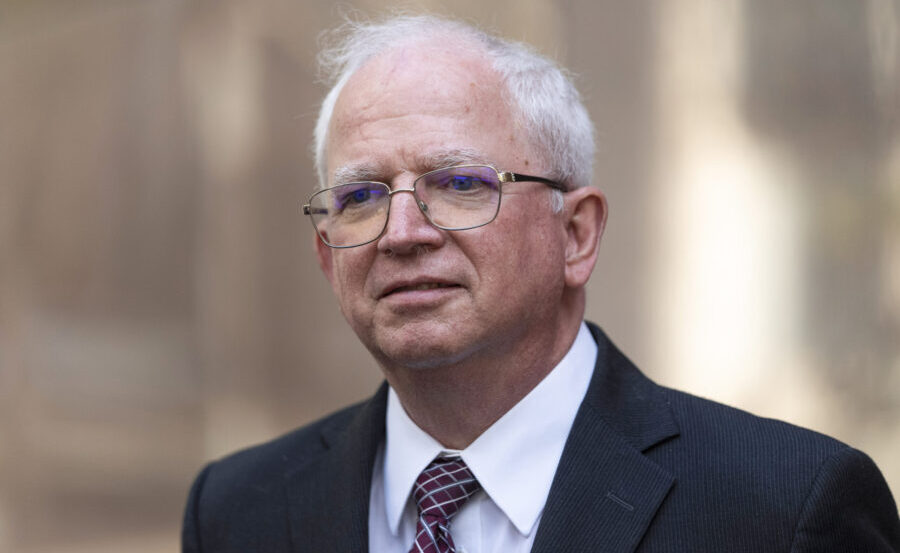Murder Case Against Ex-Cop In Floyd’s Death Goes To The Jury
Apr 19, 2021, 3:26 PM | Updated: Dec 30, 2022, 10:17 pm

A general view outside the Hennepin County Government Center on April 9, 2021 in Minneapolis, Minnesota. (Photo by Stephen Maturen/Getty Images)
(Photo by Stephen Maturen/Getty Images)
MINNEAPOLIS (AP) — The murder case against former Minneapolis police Officer Derek Chauvin in the death of George Floyd has gone to the jury.
Twelve jurors — six of them white, six Black or multiracial — are beginning deliberations in a city on edge against another round of unrest.
During closing arguments Monday, prosecutors contended that Chauvin squeezed the life out of Floyd by pinning his knee against Floyd’s neck last May, ignoring bystanders, his own training and common sense.
The defense argued that the now-fired white officer acted reasonably and that the 46-year-old Black man died of an underlying heart condition and illegal drug use.
THIS IS A BREAKING NEWS UPDATE. AP’s earlier story follows below.
MINNEAPOLIS (AP) — Officer Derek Chauvin “had to know” he was squeezing the life out of George Floyd as the Black man cried over and over that he couldn’t breathe and finally fell silent, a prosecutor told the jury Monday during closing arguments at Chauvin’s murder trial.
“Use your common sense. Believe your eyes. What you saw, you saw,” Steve Schleicher said, referring to the excruciating bystander video of Floyd pinned to the pavement with Chauvin’s knee on or close to his neck last May for up to 9 minutes, 29 seconds, as bystanders yelled at the white officer to get off.
Chauvin attorney Eric Nelson countered by arguing that Chauvin did what any “reasonable” police officer would have done after finding himself in a “dynamic” and “fluid” situation involving a large man struggling with three officers.
As Nelson began speaking, the now-fired Chauvin removed his COVID-19 mask in front of the jury for one of the very few times during the trial.
The dueling arguments got underway with Minneapolis on edge after Floyd’s death last spring set off protests in the city and across the U.S. that at times turned violent.
The defense contends not only that Chauvin acted reasonably but that the 46-year-old Floyd died of heart disease and illegal drug use, not Chauvin’s actions.
Prosecutor Jerry Blackwell had the final word, offering the state’s rebuttal argument. The prosecutor, who is Black, said that the questions about the use of force and cause of death are “so simple that a child can understand it.”
“In fact, a child did understand it, when the 9-year-old girl said, ‘Get off of him,’” Blackwell said, referring to a young witness who objected to what she saw. “That’s how simple it was. `Get off of him.’ Common sense.”
Under the law, police are given certain latitude to use force, and their actions are supposed to be judged according to what a “reasonable officer” in the same situation would have done — a point the defense stressed repeatedly.
Nelson noted that officers who first went to the corner store where Floyd allegedly tried to pass a counterfeit $20 bill already were struggling with Floyd when Chauvin arrived as backup. The attorney also noted that the first two officers on the scene were rookies and that police had been told that Floyd might be on drugs.
“A reasonable police officer understands the intensity of the struggle,” Nelson said, saying that Chauvin’s body-worn camera and his police badge were knocked off his chest.
During the prosecution’s argument, Schleicher replayed portions of the bystander video and other footage as he dismissed certain defense theories about Floyd’s death as “nonsense,” saying Chauvin killed Floyd by constricting his breathing.
Schleicher rejected the drug overdose argument, as well as the contention that police were distracted by hostile onlookers, that Floyd had “superhuman” strength from a state of agitation known as excited delirium, and that he suffered possible carbon monoxide poisoning from auto exhaust.
The prosecutor sarcastically referred to the idea that it was heart disease that killed Floyd as an “amazing coincidence.”
“Is that common sense or is that nonsense?” Schleicher asked the racially diverse jury.
But Nelson said the prosecution brought in experts to testify that Floyd died because of asphyxia, or lack of oxygen, while the person who actually performed the autopsy, the county medical examiner, reached a different finding.
Hennepin County Medical Examiner Dr. Andrew Baker, who ruled Floyd’s death a homicide, said Floyd’s heart gave out because of the way police held him down. He listed Floyd’s drug use and underlying health problems as contributing factors.
Nelson also showed the jury pictures of pills found in Floyd’s SUV and pill remnants discovered in the squad car. Fentanyl and methamphetamine were found in Floyd’s system.
The defense attorney said the failure of the prosecution to acknowledge that medical problems or drugs played a role “defies medical science and it defies common sense and reason.”
But Blackwell said prosecutors only have to prove that Chauvin’s actions were a substantial causal factor in his death, not the sole cause.
He also ridiculed the idea that Floyd, who didn’t have a pulse, would come “back to life” and go on a “rampage.”
“That’s the sort of thing you see in Halloween movies., ladies and gentlemen, not in real life. Not in real life,” Blackwell said.
And he rejected the theory that Floyd died because of an enlarged heart: “The truth of the matter is that the reason George Floyd is dead is because Mr. Chauvin’s heart was too small.”
Earlier, fellow prosecutor Schleicher described how Chauvin ignored Floyd’s cries and continued to kneel on him well after he stopped breathing and had no pulse.
Chauvin was “on top of him for 9 minutes and 29 seconds and he had to know,” Schleicher said. “He had to know.”
He said Chauvin “heard him, but he just didn’t listen.”
The prosecutor further argued that Floyd was “not a threat to anyone” and wasn’t trying to escape when he struggled with officers. Instead, Schleicher said, he was terrified of being put into the tiny backseat of the squad car.
He said a reasonable officer with Chauvin’s training and experience — he was a 19-year Minneapolis police veteran — should have sized up the situation accurately.
Chauvin, wearing a light gray suit with a blue shirt and blue tie, showed little expression as he watched himself and the other officers pinning Floyd to the ground on bodycam video played by his attorney. He cocked his head to the side and occasionally leaned forward to write on a notepad.
An unidentified woman occupied the single seat set aside in the pandemic-spaced courtroom for a Chauvin supporter.
Floyd’s brother Philonise represented the family in court, as he often has during the trial.
Schleicher also noted that Chauvin was required to use his training to provide medical care to Floyd but ignored bystanders, rebuffed help from an off-duty paramedic and rejected a suggestion from another officer to roll Floyd onto his side.
“He could have listened to the bystanders. He could have listened to fellow officers. He could have listened to his own training. He knew better. He just didn’t do better,” Schleicher said.
“Conscious indifference. Indifference. Do you want to know what indifference is and sounds like?” Schleicher asked before playing a video of Chauvin replying, “Uh-huh” several times as Floyd cried out.
Nelson, in a closing argument that took about 2 hours and 45 minutes, played portions of bystander video that showed the increasingly agitated onlookers shouting at Chauvin to get off Floyd’s neck. He said officers may have determined it wasn’t safe to render medical aid to Floyd in that environment.
Nelson described what he called a “critical moment”: Floyd took his last breath, Chauvin reacted to the crowd by taking out his Mace and threatening a use of force, and the off-duty paramedic walked up behind Chauvin, startling him.
“And that changed Officer Chauvin’s perception of what was happening,” Nelson said. He added: “I cannot, in my opinion, understate the importance of this moment.”
The downtown courthouse is surrounded by concrete barriers and razor wire, in a city heavily fortified by National Guard members and just days after a new round of unrest over the police killing of a 20-year-old Black man in a nearby suburb. Some businesses boarded up their storefronts with plywood.
Chauvin, 45, is charged with second-degree murder, third-degree murder and second-degree manslaughter. All three charges require the jury to conclude that Chauvin’s actions were a “substantial causal factor” in Floyd’s death and that his use of force was unreasonable.
Second-degree intentional murder carries up to 40 years in prison, third-degree murder 25 years, and second-degree manslaughter 10 years. Sentencing guidelines call for far less time, including 12 1/2 years on either murder count.
Webber reported from Fenton, Michigan. Associated Press video journalist Angie Wang in Atlanta and writer Mohamed Ibrahim contributed.













